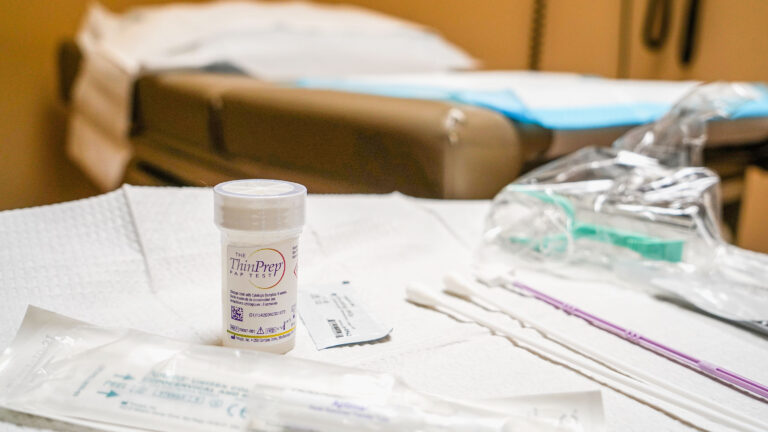by Angus Chen
New research suggests that cervical cancer screenings could be used to pick up on a patient’s risk of breast, ovarian, and endometrial cancers.
Routine screenings have become a powerful tool in catching cervical cancer as early as possible. Now, research suggests the cervical cells collected during these exams could hold the key to efficient screening for other gynecological cancers, too.
A new study suggests that by analyzing cervical cells’ genomes, researchers might be able to find genetic signatures that predict the risk of ovarian, breast, and endometrial cancers and flag patients that should be screened more aggressively. If the test proves useful in larger studies, it could offer a simple way to piggyback off of regular Pap smears already used to screen for cancerous or precancerous lesions in the cervix.
“One sample and then you could utilize this sample for predicting the risk for all four gynecological cancers: breast, ovarian, endometrial, and cervical cancer,” said Martin Widschwendter, a professor of cancer prevention and screening at Innsbruck University in Austria and a senior author on the study. “You want to make it easy. If it’s not convenient, then women likely won’t utilize it.”
The test looks for something known as methylation patterns in the genomes of cervical cells. Over the course of a lifetime, beginning in utero, a patient’s cells accumulate chemical modifications to their genomes. Unlike genetic mutations, these don’t change a cell’s genetic code but rather are like molecular “caps,” called methylations, that attach to the DNA and can turn certain genes on or off.
There are many factors that affect the pattern of DNA methylation in cervical cells including exposure to certain levels of chemicals or hormones like progesterone that can alter someone’s risk of cancer. In that sense, such changes in cervical cells might be a readout of a patient’s overall history that has an impact on cancer risk.
“Our idea was that these hormone-sensitive cells are recording these lifelong exposures in the epigenome,” said Widschwendter, who set out to find whether a specific signature in the cells could offer any clues about cancer risk.
He and his colleagues examined samples from cervical smears of roughly 2,000 women at 15 different health centers in Europe. Some of the women had ovarian or breast cancer, some were healthy, and some had a high suspicion of having ovarian or breast cancer but had not yet been diagnosed. The study didn’t disclose the full demographic breakdown of the cohort, but said an analysis suggested ethnicity — designated as white and non-white — did not seem to have an impact on the overall risk scores.
The team analyzed half of the samples and then used that data to train an algorithm to discover methylation signatures in the cervical cells that correlate with gynecological cancer risk.
Then, the researchers asked the algorithm to predict which patients in the other half of the database were at a high risk of gynecological cancer. When they stratified women into different risk groups, Widschwendter said that 70 to 75% of all ovarian and breast cancers could be found in the highest risk group. The team published their results in two papers in Nature Communications on Tuesday.
That suggests the analysis is able to accurately group patients by risk, said Shelley Tworoger, a cancer prevention researcher at the Moffitt Cancer Center. That could make a difference in developing better screening strategies to monitor women who are at the greatest risk. But, she added, it may be some time before the test yields much clinical utility on a large scale.
“Conceptually, I think this is a very interesting approach. Looking at methylation is a way we might be able to have an integrated view of the exposures a woman may have had in her lifetime that might affect her cancer risk,” she said. “It’s difficult to directly access [the ovaries or uterus] to identify cancer or precancerous lesions, so this might be a good way to identify people at high risk. Most women go in and get Pap smears so we already have this type of sample from women on a very regular basis.”
There are technologies to screen women for ovarian or endometrial cancer, including a blood test called CA 125 and ultrasound imaging. The problem with these methods, thus far, is that they haven’t been able to show that they can catch cancers at earlier stages when treatment has the best chance at success, Tworoger said. “But if we had women who we knew were at higher risk, maybe those screening modalities would work better and lead to better outcomes in them.”
Still, Tworoger said, the study helps open a new avenue of research looking more deeply into why methylations are related to cancer risk, and which might play the most significant role in predisposing someone to cancer.
“There’s the potential to learn more about the biology, and the more we understand, the better we can address the cancer either from a prevention or treatment side,” Tworoger said.


